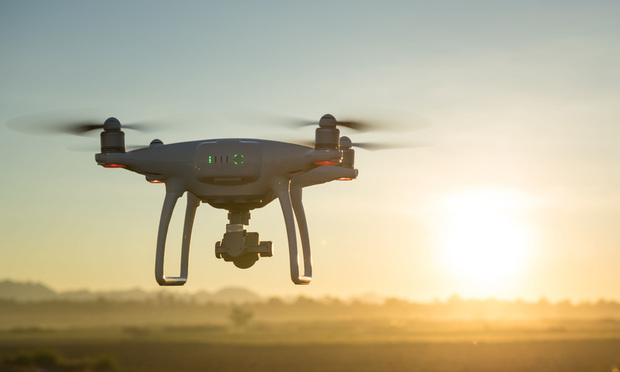Drones Will Need Warrants to Give Them Wings, Experts Say
Russ Cochran encouraged the ABA Tech Show crowd to call drones what they are: a tool. But he was also realistic enough to know that other people not view the matter quite so simply.
February 28, 2019 at 12:18 PM
2 minute read

Fun fact: If a drone drops out of the sky and hits a car traveling on the highway, it's technically considered a traffic collision. That's the kind of icebreaker you can only pick up at the “All About Drones: Legal, Practical and Educational Applications” panel at the ABA Tech Show in Chicago.
The panel session was led by Kenton Brice from the University of Oklahoma College of Law and Russ Cochran, general counsel for the Oklahoma Bureau of Narcotics and Dangerous Drugs Control.
Cochran encouraged those in attendance to call drones what they are: a tool. But he was also realistic enough to know that other people not view the matter quite so simply.
“We don't have too many presentations like this on ball-peen hammers,” Cochran said.
Legal disputes regarding the ownership of air space over private property date back to United States v. Causby, a Supreme Court case involving a military aircraft that flew so low that it literally scared a farmer's chickens to death. The court held that ownership of the land included dominion over the lower altitudes (which in the case of the farmer was about 83 feet above his property).
While chickens might not be too crazy about low-flying aircraft, police find drones useful for gathering evidence or scoping out any threats that might be waiting for them inside a given location.
Though there are no Supreme Court cases dealing specifically with drone use, law enforcement still has to comply with laws that differ from state to state. Per Cochran, there are 18 states that regulate the ways that law enforcement makes use of drones.
Only 13 of those currently require search warrants, but Cochran suggested that trends in the way the courts are approaching technology—the Supreme Court ruled in Riley v. California that cell phone searches require warrants, for example—point to more on the horizon.
“You see the trend where case law is going. We've got to do it right. That means that you need to develop your probable cause,” Cochran said.
This content has been archived. It is available through our partners, LexisNexis® and Bloomberg Law.
To view this content, please continue to their sites.
Not a Lexis Subscriber?
Subscribe Now
Not a Bloomberg Law Subscriber?
Subscribe Now
NOT FOR REPRINT
© 2025 ALM Global, LLC, All Rights Reserved. Request academic re-use from www.copyright.com. All other uses, submit a request to [email protected]. For more information visit Asset & Logo Licensing.
You Might Like
View AllTrending Stories
- 1How the Court of Public Opinion Should Factor Into Litigation Strategy
- 2Debevoise Lures Another SDNY Alum, Adding Criminal Division Chief
- 3Cooley Promotes NY Office Leader to Global Litigation Department Chair
- 4What Happens When Lateral Partners’ Guaranteed Compensation Ends?
- 5Tuesday Newspaper
Who Got The Work
J. Brugh Lower of Gibbons has entered an appearance for industrial equipment supplier Devco Corporation in a pending trademark infringement lawsuit. The suit, accusing the defendant of selling knock-off Graco products, was filed Dec. 18 in New Jersey District Court by Rivkin Radler on behalf of Graco Inc. and Graco Minnesota. The case, assigned to U.S. District Judge Zahid N. Quraishi, is 3:24-cv-11294, Graco Inc. et al v. Devco Corporation.
Who Got The Work
Rebecca Maller-Stein and Kent A. Yalowitz of Arnold & Porter Kaye Scholer have entered their appearances for Hanaco Venture Capital and its executives, Lior Prosor and David Frankel, in a pending securities lawsuit. The action, filed on Dec. 24 in New York Southern District Court by Zell, Aron & Co. on behalf of Goldeneye Advisors, accuses the defendants of negligently and fraudulently managing the plaintiff's $1 million investment. The case, assigned to U.S. District Judge Vernon S. Broderick, is 1:24-cv-09918, Goldeneye Advisors, LLC v. Hanaco Venture Capital, Ltd. et al.
Who Got The Work
Attorneys from A&O Shearman has stepped in as defense counsel for Toronto-Dominion Bank and other defendants in a pending securities class action. The suit, filed Dec. 11 in New York Southern District Court by Bleichmar Fonti & Auld, accuses the defendants of concealing the bank's 'pervasive' deficiencies in regards to its compliance with the Bank Secrecy Act and the quality of its anti-money laundering controls. The case, assigned to U.S. District Judge Arun Subramanian, is 1:24-cv-09445, Gonzalez v. The Toronto-Dominion Bank et al.
Who Got The Work
Crown Castle International, a Pennsylvania company providing shared communications infrastructure, has turned to Luke D. Wolf of Gordon Rees Scully Mansukhani to fend off a pending breach-of-contract lawsuit. The court action, filed Nov. 25 in Michigan Eastern District Court by Hooper Hathaway PC on behalf of The Town Residences LLC, accuses Crown Castle of failing to transfer approximately $30,000 in utility payments from T-Mobile in breach of a roof-top lease and assignment agreement. The case, assigned to U.S. District Judge Susan K. Declercq, is 2:24-cv-13131, The Town Residences LLC v. T-Mobile US, Inc. et al.
Who Got The Work
Wilfred P. Coronato and Daniel M. Schwartz of McCarter & English have stepped in as defense counsel to Electrolux Home Products Inc. in a pending product liability lawsuit. The court action, filed Nov. 26 in New York Eastern District Court by Poulos Lopiccolo PC and Nagel Rice LLP on behalf of David Stern, alleges that the defendant's refrigerators’ drawers and shelving repeatedly break and fall apart within months after purchase. The case, assigned to U.S. District Judge Joan M. Azrack, is 2:24-cv-08204, Stern v. Electrolux Home Products, Inc.
Featured Firms
Law Offices of Gary Martin Hays & Associates, P.C.
(470) 294-1674
Law Offices of Mark E. Salomone
(857) 444-6468
Smith & Hassler
(713) 739-1250






